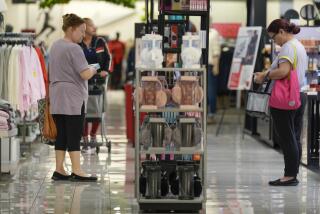Fall in Consumer Prices Ends--0.2% Rise in May : Smaller-Than-Expected Increase Tied to Rebound in Oil Costs; Analysts Say Trend Still Favorable
WASHINGTON — The three-month plunge in consumer prices, the steepest in almost 40 years, came to a quiet end in May with a modest 0.2% increase in retail prices, the Labor Department reported Friday.
An end to the deflationary binge that produced a declining consumer price index in February, March and April had been expected ever since a small rebound in the cost of energy pushed up wholesale prices by 0.6% last month. But the actual rise was less than anticipated, thanks to smaller-than-expected increases in non-energy goods.
For the first five months of the year, retail prices have fallen 1.4%, the sharpest price drop for any year’s beginning since such records have been kept. The February-to-April drop was the steepest three-month decline since 1949.
Higher in L.A., Orange Counties
Inflation has exceeded the national average in the Los Angeles-Orange County area, rising at a 3.2% rate over the past 12 months, compared to a 1.6% rate nationwide. Retail prices in May rose 0.8%, the largest one-month increase in the area since last August.
But on balance, prospects for controlling inflation continue to be bright, with private economists generally agreeing that the double-digit rates of the late 1970s are nowhere in sight. The consensus: inflation at well under 3% this year and not much more than 4% next year.
White House spokesman Larry Speakes hailed the report but conceded that the big fall in prices caused by the collapse of crude oil costs is now over. “The drop in inflation since January was due almost entirely to the immediate effects of falling world energy prices, and the modest May increase reflects the fact that those effects have now been largely absorbed,” Speakes said in a statement. “With inflation still under control and consumer spending up, we expect continued brisk activity in the consumer sector.”
“It was pretty much as expected, except it was on the low side,” said David Wyss of Data Resources, a Lexington, Mass., forecasting firm. While a 2.5% increase in retail gasoline prices was responsible for most of the May increase, Wyss noted that wholesale gasoline prices last month rose even more--8.5%.
‘Best Price News Is Over’
But fuel oil, electricity and natural gas prices all continued to decline, and the small gasoline price increase--after a drop of 26.5% in the previous three months--has only returned gasoline prices to their level of mid-1979.
Wyss also pointed out that 1.9% and 2.6% declines in used car prices and auto financing charges offset a relatively modest 0.8% increase in new car prices. Clothing prices and the cost of housing were each down 0.1%, while the 0.4% increase in food prices was slightly less than expected.
In sum, Wyss noted, the trend for prices of goods is for a slight rise or no gain, while prices for most services will continue to go up at an annual rate of about 4%. Medical care costs continued to lead the services price parade, up 0.6% in May--a 7.4% increase over the past 12 months and an 8.4% annual rate of gain over the past three months. “For the rest of the year, the best price news is over,” Wyss summed up. “If you take out food and energy, prices have been rising about 4%, and that’s where we think we’re going.”
“It’s not a worrisome development at all,” said Robert F. Wescott of Wharton Econometrics, a Philadelphia forecasting firm. “The broad story remains in place. Even without the energy and food declines, we’re looking at a 4% underlying rate of inflation, so there’s nothing unusual about it. The fundamentals are good. Wage-increase patterns are very moderate and even show signs of decelerating, so the chances of a rapid resurgence of inflation are extremely small.”
Added Dorothea Otte, assistant director of an economic forecasting project at Georgia State University and a specialist in price movements: “The party is over, about on schedule, and we can expect to see some higher numbers for the rest of the year. That means the spending boost in the second half of the year that we hoped to see from cheaper fuel won’t happen . . . so there will be less growth than the Administration has forecast.”
The Administration predicted 4% growth in the gross national product from the end of 1985 to the end of 1986. But the Commerce Department earlier this week revised downward its first-quarter estimate for annual growth to 2.9% from 3.7%. Few economists see better than 2% growth from April through June.
This makes the hoped-for 4% year-over-year expansion virtually unattainable. The probable return of a 4% annual inflation rate, Otte suggested, will make that goal still more remote. “It was nice while it lasted,” Otte said.
More to Read
Inside the business of entertainment
The Wide Shot brings you news, analysis and insights on everything from streaming wars to production — and what it all means for the future.
You may occasionally receive promotional content from the Los Angeles Times.










